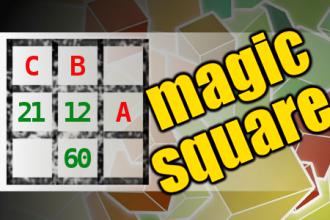MAGIC SQUARE: Calculate A+B*C
The aim is to place the some numbers from the list (12, 13, 16, 17, 18, 20, 21, 26, 56, 57, 60, 83) into the empty squares and squares marked with A, B an C. Sum of each row and column should be equal. All the numbers of the magic square must be different. Find values for A, B, and C. Solution is A+B*C.Correct answers: 0
#brainteasers #math #magicsquare

Two drunken men were driving h...
Two drunken men were driving home. The first started screaming: - Jim, watch out for the wall, watch out for the waaaaall! Baaaaam! They hit the wall. The next day in the hospital the first man asked his friend: - You good for nothing, I've been screaming for you to watch out, why didn't you? Jim answered him: - IT WAS YOU DRIVING!!!

